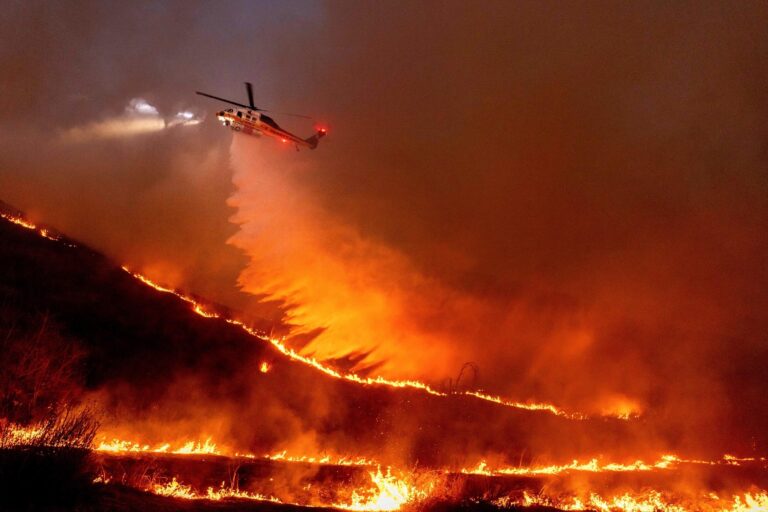California Wildfires: Current Situation and Effects on Los Angeles Communities
California is once again facing a severe wildfire crisis, with multiple fires rapidly advancing across the Los Angeles region.These infernos, driven by a combination of extended drought conditions, soaring temperatures, and powerful Santa Ana winds, have consumed tens of thousands of acres. The fires have triggered mass evacuations, endangered residential and commercial properties, and severely disrupted everyday life for thousands of Angelenos.
Preliminary investigations suggest that dry vegetation and compromised electrical infrastructure, including fallen power lines, are notable ignition sources. Firefighting teams remain actively engaged,focusing on protecting lives,homes,and critical facilities amid challenging weather conditions.
Areas most severely impacted include:
- Sections of the San Fernando Valley
- Communities adjacent to Griffith Park
- Residential zones within the Santa Monica Mountains
The consequences are profound: thousands have been displaced, schools have temporarily shut down, and air pollution levels have soared to hazardous thresholds. Local authorities have launched extensive relief operations, including opening emergency shelters and distributing protective masks to mitigate smoke-related health risks.Below is a summary of the latest wildfire statistics and response efforts:
| Metric | Latest Figures | Remarks |
|---|---|---|
| Acres Affected | Over 27,000 | Fire continues to spread due to strong winds |
| Evacuated Residents | More than 12,000 | Primarily in northern Los Angeles neighborhoods |
| Containment Level | Approximately 45% | Firefighting efforts ongoing around the clock |
| Firefighting Personnel | 1,500+ | Reinforcements from neighboring counties deployed |
Decoding the Causes Behind the Recent Los Angeles Wildfires
The wildfires currently ravaging the Los Angeles area stem from a multifaceted combination of environmental and human influences. Central to the crisis is the prolonged drought that has desiccated vast expanses of vegetation, rendering it highly flammable. Coupled with this, unusually strong Santa Ana winds have accelerated the fires’ spread, complicating containment efforts.
Investigations have also highlighted the role of aging electrical infrastructure, with several fires traced back to downed or faulty power lines amid dry and windy conditions. Experts underscore climate change as a pivotal factor,intensifying heatwaves and creating erratic weather patterns that heighten wildfire risks year after year.
Key contributing elements identified include:
- Prolonged drought leading to parched, combustible vegetation
- High-velocity winds facilitating rapid fire expansion
- Electrical system malfunctions due to outdated equipment and vegetation interference
- Human-related causes, such as accidental ignitions and unattended campfires
| Cause | Effect | Current Status |
|---|---|---|
| Drought Conditions | Increased availability of dry fuel for fires | Persistent concern |
| Wind Events | Accelerated fire propagation and flare-ups | Occasional but impactful |
| Electrical Failures | Multiple ignition points identified | Under active investigation |
| Human Activity | Unintentional fire starts | Monitored and addressed |
Who Bears the Greatest Burden and How Relief Operations Are Being Managed
Residents in the Los Angeles metropolitan area are enduring the most severe consequences of the wildfires. Those living in wildland-urban interface zones—where residential areas meet forests and grasslands—face heightened vulnerability due to the proximity of flammable vegetation. Economically disadvantaged communities often experience amplified hardships,lacking sufficient resources for evacuation and recovery. Vulnerable groups such as seniors, people with disabilities, and families with young children encounter additional obstacles, including transportation challenges and limited access to emergency shelters. Local businesses are also suffering,with disruptions causing economic instability and job losses.
Relief efforts are being executed through a collaborative network of agencies and organizations, ensuring efficient resource deployment and unified response strategies. Key participants include:
- Emergency responders: Firefighters, paramedics, and law enforcement coordinate evacuation and containment operations.
- Government agencies: State and county emergency management offices oversee logistics, communication, and funding allocation.
- Nonprofit organizations: Entities such as the American Red Cross provide shelter, nourishment, and psychological support to displaced individuals.
- Community volunteers: Local residents assist in distributing supplies and facilitating recovery efforts.
| Institution | Function | Current Engagement |
|---|---|---|
| Cal Fire | Fire suppression and containment | Deploying over 1,000 personnel on-site |
| American Red Cross | Operating emergency shelters and providing aid | Five shelters active, assisting 800+ evacuees |
| L.A. County Office of Emergency Management | Coordination and public communication | Maintaining active command centers |
| Local NGOs | Distribution of essentials and donations | Volunteers mobilized around the clock |
Critical Fire Safety Practices and Preparedness Recommendations for Residents
For those residing in wildfire-prone zones, prioritizing both immediate safety and long-term preparedness is vital to safeguarding lives and property. Developing and routinely updating a complete evacuation plan is essential, ensuring all household members are familiar with multiple escape routes and designated rendezvous points. Preparing an emergency “go-bag” stocked with important documents, medications, water, non-perishable food, and personal necessities can facilitate swift evacuation when required. Staying alert through official channels—such as local fire departments, emergency alert systems, and reliable news sources—enables timely responses to evolving fire conditions.
Additional preparedness actions include:
- Removing dry brush, dead trees, and combustible debris within at least 30 feet of the home
- Incorporating fire-resistant plants and construction materials in landscaping and home maintenance
- Installing smoke detectors on every floor and testing them weekly
- Establishing communication plans with neighbors and local emergency services
- Keeping vehicles fueled and ready for immediate evacuation
| Preparedness Activity | Suggested Frequency |
|---|---|
| Update Emergency Kit | Every 6 months |
| Maintain Firebreaks | Seasonally |
| Conduct Evacuation Drills | Annually |
| Test Smoke Alarms | Weekly |
| Subscribe to Local Alerts | Ongoing |
Conclusion: Navigating the Ongoing Wildfire Challenge in Los Angeles
As wildfires continue to challenge the Los Angeles region, gaining a clear understanding of their origins and far-reaching impacts is more critically important than ever. Fire containment and community support efforts remain active, underscoring the necessity for coordinated emergency responses and proactive prevention strategies. With wildfire seasons intensifying due to climate change, staying informed and prepared is crucial for residents and policymakers alike. Our coverage will persist in delivering timely updates on this evolving situation and its broader implications for Southern California.




